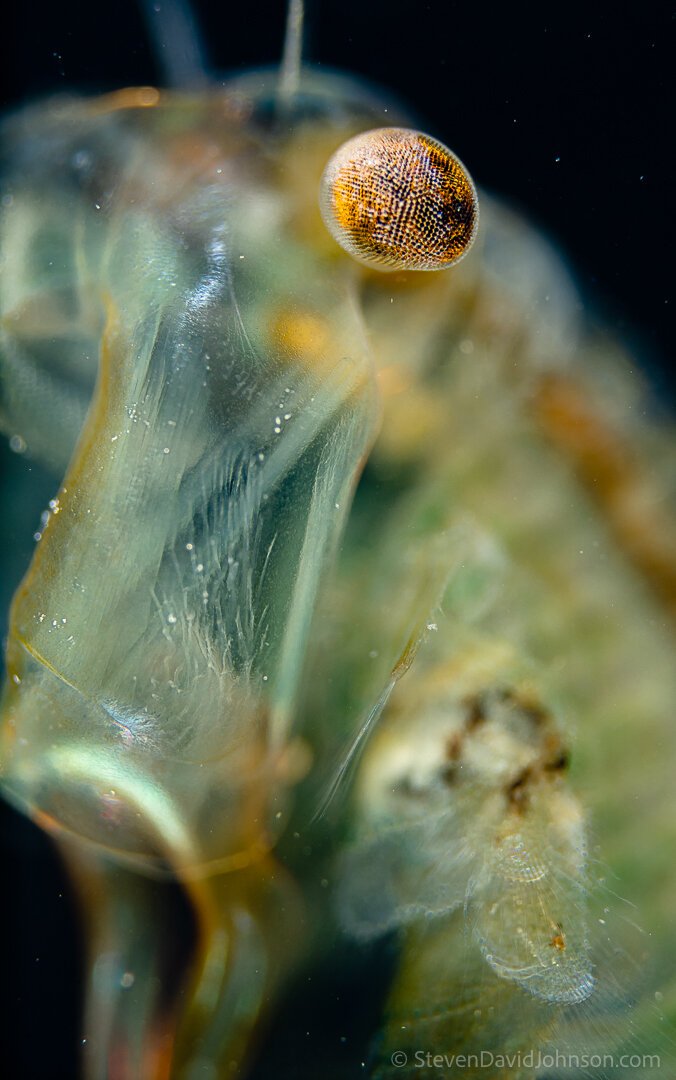Vernal Pools Macroinvertebrates
While amphibians may be the first creatures we associate with vernal pools, many types of invertebrates share these environments. These include obligate species like fairy shrimp, a variety of aquatic insects and insect larvae, and tiny daphnia and hydra.
Some invertebrates, such as tiny copepods, are prey animals for salamander larvae and may appear in vast numbers, forming large orange-red clouds in vernal pools. Other invertebrates, like beetle larvae, may turn the tables and prey on amphibian eggs or even developing frog tadpoles.
Fairy Shrimp are indicator species for vernal pools. Photographed with 3.5:1 macro setting, this male shows the enlarged antennae that are used as graspers during breeding.
Predators of the shallows, a dragonfly larva lurks below the surface of a vernal pool in the George Washington National Forest of Virginia.
In this detail crop, a copepod (a type of tiny crustacean) shows its single blue eye. Estimated size of creature: 2mm.Photographed in situ in a vernal pool in the George Washington National Forest of Virginia.
Like a mashup of mythical beasts, diminutive daphnia sport a single eye centered between antler-like antennae. Photographed in situ in the George Washington National Forest of Virginia. Estimated size 1-2mm (not including antennae).
Diving Beetle larva
Daphnia and Copepod
Seed Shrimp (Ostracods) are pin-head sized crustaceans that sometimes inhabit vernal pools. In this ultra macro image, they line up below a Wood Frog egg. Photographed in situ in a vernal pool.
Rotated 90 degrees to form a portrait orientation, a vernal pool Fairy Shrimp shows its claspers and compound eye.
In the ultra macro world, there are many surprises, and I love encountering the unknown without expectations. When this winged, ethereal entity (only millimeters long) pulsed into my viewfinder, it was just extraordinary ... like a deep sea creature had come to visit the forests of Virginia.I took me hours of research before I placed it as the larval stage of a fairy shrimp (here pictured with a copepod to the left). Photographed in situ in the George Washington National Forest.
In this detail crop, a copepod (a type of tiny crustacean) shows its single blue eye. Estimated size of creature: 2mm. Photographed in situ in a vernal pool in the George Washington National Forest of Virginia.
A tiny, red water mite explores just below the surface of a vernal pool.
Like an opalescent heart, a daphnia hovers below the surface of a vernal pool in the George Washington National Forest. When I told my 16 year old daughter about daphnia, she suggested that they were probably named after the Daphne of Greek Mythology who was tranformed into a laurel tree after an unwanted pursuit by Apollo. Sure enough, a Scientific American article confirms the etymology, referencing both the branch-like antennae and the fact that daphnia can reproduce without males. https://www.scientificamerican.com/article/daphnia-genome/ Photographed in situ in a vernal pool in the George Washington National Forest of Virginia.












